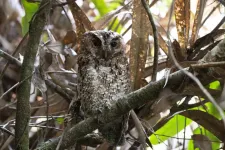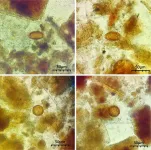(Press-News.org) COLUMBUS, Ohio - A giant saber-toothed cat lived in North America between 5 million and 9 million years ago, weighing up to 900 pounds and hunting prey that likely weighed 1,000 to 2,000 pounds, scientists reported today in a new study.
The researchers completed a painstaking comparison of seven uncategorized fossil specimens with previously identified fossils and bone samples from around the world to describe the new species. Their finding makes a case for the use of the elbow portion of the humerus - in addition to teeth - to identify fossils of large saber-toothed cats whose massive forearms enabled them to subdue their prey.
The newly identified cat weighed an average of around 600 or so pounds and could have managed to kill prey weighing up to 6,000 pounds, the scientists estimate, suggesting that their findings provide evidence for another giant cat, one of the largest in Earth history.
"We believe these were animals that were routinely taking down bison-sized animals," said study co-author Jonathan Calede, an assistant professor of evolution, ecology and organismal biology at The Ohio State University's Marion campus. "This was by far the largest cat alive at that time."
Calede completed the study with John Orcutt, assistant professor of biology at Gonzaga University, who initiated the project. Orcutt found a large upper arm bone specimen that had been labeled as a cat in the University of Oregon Museum of Natural and Cultural History collection when he was a graduate student, and collaborated with Calede on the years-long effort to figure out what kind of cat it could be.
They have determined that the new species is an ancient relative of the best-known saber-toothed cat Smilodon, the famous fossil found in the La Brea Tar Pits in California that went extinct about 10,000 years ago.
The Oregon specimen was excavated on the traditional lands of the Cayuse, a tribe joined with the Umatilla and Walla Walla in the Confederated Tribes of the Umatilla Indian Reservation. In recognition of its origin, Calede and Orcutt collaborated with the Tamástslikt Cultural Institute to name the new species Machairodus lahayishupup. Machairodus is a genus of large saber-toothed cats that lived in Africa, Eurasia and North America, and in the Old Cayuse language, Laháyis Húpup means "ancient wild cat."
The study is published today (May 3, 2021) in the Journal of Mammalian Evolution.
Orcutt and Calede found similar uncategorized upper arm fossil specimens at the Idaho Museum of Natural History, where a big cat forearm was accompanied by teeth - generally considered the gold standard for identifying new species - as well as at the University of California Museum of Paleontology and Texas Memorial Museum.
"One of the big stories of all of this is that we ended up uncovering specimen after specimen of this giant cat in museums in western North America," Orcutt said. "They were clearly big cats. We started with a few assumptions based on their age, in the 5 1/2 to 9 million-year-old range, and based on their size, because these things were huge.
"What we didn't have then, that we have now, is the test of whether the size and anatomy of those bones tells us anything - and it turns out that yes, they do."
The largest of the seven Machairodus lahayishupup humerus fossils available for the analysis was more than 18 inches long and 1.7 inches in diameter. By comparison, the average modern adult male lion's humerus is about 13 inches long.
The researchers hypothesized that if an isolated forearm bone were useful in telling species apart, that would be true among the big cat species alive today. Calede and Orcutt visited numerous museums in the U.S., Canada and France to photograph forearm specimens of lions, pumas, panthers, jaguars and tigers, as well as fossils of previously identified extinct big cats.
Calede used software to place landmark points on each digitized sample that, when drawn together, would create a model of each elbow.
"We found we could quantify the differences on a fairly fine scale," Calede said. "This told us we could use the elbow shape to tell apart species of modern big cats.
"Then we took the tool to the fossil record - these giant elbows scattered in museums all had a characteristic in common. This told us they all belonged to the same species. Their unique shape and size told us they were also very different from everything that is already known. In other words, these bones belong to one species and that species is a new species."
The researchers calculated estimates of the new species' body size based on the association between humerus size and body mass in modern big cats, and speculated about the cat's prey based on its size and animals known to have lived in the region at that time: rhinoceros were particularly abundant, as well as giant camels and giant ground sloths.
The teeth from the Idaho Museum of Natural History came from the lower part of the jaw and did not include the saber-shaped canines, but provided additional evidence that the fossil belonged to the Machairodus genus, which gave its name to the machairodontines - the technical name for a saber-toothed cat, Orcutt said.
"We're quite confident it's a saber-toothed cat and we're quite confident it's a new species of the Machairodus genus," he said. "The problem is, in part because we haven't necessarily had a clear image in the past of how many species were out there, our understanding of how all these saber-toothed cats are related to each other is a little fuzzy, particularly early in their evolution."
Establishing that the humerus alone can be analyzed to identify a fossil cat has important implications for the field - saber-toothed cats' "big, beefy" forearm bones are the most common specimens of fossil cats found in excavations, he said.
Only a reconstruction of the evolutionary history of saber-toothed cats can determine where this new species fits in, but Orcutt and Calede believe Machairodus lahayishupup existed early in the evolution of the group.
A discovery that this giant cat in North America existed at the same time similar animals lived around the world also raises another evolutionary question, Calede said.
"It's been known that there were giant cats in Europe, Asia and Africa, and now we have our own giant saber-toothed cat in North America during this period as well," he said. "There's a very interesting pattern of either repeated independent evolution on every continent of this giant body size in what remains a pretty hyperspecialized way of hunting, or we have this ancestral giant saber-toothed cat that dispersed to all of those continents.
"It's an interesting paleontological question."
INFORMATION:
This work was supported by Gonzaga University, the M.J. Murdock Charitable Trust, startup funds from Ohio State and an Ohio State College of Arts and Sciences Regional Campus Research and Creative Activity Grant.
Contacts:
Jonathan Calede, calede.1@osu.edu
John Orcutt, Orcutt@gonzaga.edu
Written by Emily Caldwell, Caldwell.151@osu.edu
Editor's note:
Pronunciation of Machairodus lahayishupup:
Mah-CHI-rho-duss Lah-HIGH-ees-hoop-oop
CHAPEL HILL, North Carolina--A comprehensive review by University of North Carolina researchers and colleagues highlights the optimal ways that focused, high-dose radiation can be delivered to various types of tumors while sparing normal tissue and mitigating long-term side effects. The review was reported as a special issue in the International Journal of Radiation Oncology, Biology, Physics on May 1, 2021.
This analysis was based on an exhaustive review of data and the literature published largely in the past decade. It updates an earlier review that primarily focused on the effects of conventional radiation therapy on normal tissue. This new review also includes important analyses ...
Exposure to air pollution, even over the course of just a few weeks, can impede mental performance, according to a new study led by researchers at Columbia University Mailman School of Public Health. However, these adverse effects were lessened in people taking nonsteroidal anti-inflammatory drugs (NSAIDs) like aspirin. The study is among the first to explore short-term air pollution exposures and the use of NSAIDs to mitigate their effects. The results are published in the journal Nature Aging.
Examples of events that would increase someone's exposure to air pollution over the short term could include forest fires, smog, second-hand cigarette smoke, charcoal ...
The Bornean subspecies of Rajah scops owl (Otus brookii brookii), documented in the wild for the first time since 1892, may be its own unique species and deserving of a conservation designation. Published April 28 in The Wilson Journal of Ornithology, Smithsonian Migratory Bird Center ecologist Andy Boyce reported the rediscovery and photographed this elusive subspecies in the mountainous forests of Mount Kinabalu in Sabah, Malaysia.
"It was a pretty rapid progression of emotions when I first saw the owl--absolute shock and excitement that we'd found this mythical bird, then pure anxiety that I had to document it as fast as I could," Boyce said. "Based on size, eye color and habitat, I knew it was the Bornean Rajah scops owl. What's more, taking into ...
East Hanover, NJ. May 3, 2021. An international team of multiple sclerosis (MS) researchers showed that longitudinal changes in social cognition are associated with psychological outcomes of daily living, suggesting that social cognition may exert a central role in people with MS. The article, "Social Cognition in Multiple Sclerosis: A 3-Year Follow-Up MRI and Behavioral Study" (doi: 10.3390/diagnostics11030484) was published on March 9, 2021, in Diagnostics. It is available open access at https://www.ncbi.nlm.nih.gov/pmc/articles/PMC8001246/.
The authors are Helen M. Genova, PhD, of Kessler Foundation's Center for Neuropsychology ...
Individuals living with severe Alzheimer's disease showed remarkable improvements in behaviour and cognition within days of receiving an innovative new treatment that delivered low doses of radiation, a recent Baycrest-Sunnybrook pilot study found.
"The primary goal of a therapy for Alzheimer's disease should be to improve the patient's quality of life. We want to optimize their well-being and restore communication with family and friends to avoid social isolation, loneliness and under-stimulation. Although the study was a small pilot and should be interpreted with caution, our results suggest that low-dose radiation therapy may successfully achieve this," says Dr. Morris Freedman, scientist at Baycrest's Rotman Research ...
In the early 19th century in North America, parasitic infections were quite common in urban areas due in part to population growth and urbanization. Prior research has found that poor sanitation, unsanitary privy (outhouse) conditions, and increased contact with domestic animals, contributed to the prevalence of parasitic disease in urban areas. A new study examining fecal samples from a privy on Dartmouth's campus illustrates how rural wealthy elites in New England also had intestinal parasitic infections. The findings are published in the Journal of Archeological Science: Reports.
"Our study is one of the first to demonstrate evidence of parasitic infection in an affluent rural household in the Northeast," says co-author Theresa Gildner, who was ...
New research shows that patients who have had contact with the hospital due to serious glandular disease have a greater risk of subsequently developing depression. The study from iPSYCH is the largest yet to show a correlation between glandular fever and depression.
The vast majority of Danes have had glandular fever - also called mononucleosis - before adulthood. And for the vast majority of them, the disease can be cured at home with throat lozenges and a little extra care. But for some, the disease is so serious that they need to visit the hospital.
A new research result now shows that precisely those patients who have been in contact with the hospital in connection with their illness, have a greater risk of suffering a depression later.
"Our study ...
AUSTIN, Texas -- For people experiencing homelessness, missing proof of identity can be a major barrier to receiving critical services, from housing to food assistance to health care. Physical documents such as driver's licenses are highly susceptible to loss, theft or damage. However, researchers from Dell Medical School at The University of Texas at Austin say new technology solutions such as blockchain can be used to keep important health care information secure and portable.
"Health care institutions and social services are so fragmented and siloed they're unable to accurately collect, share or verify basic identity information about a person experiencing homelessness," said Tim Mercer, M.D., MPH, director ...
A study encompassing some 9,000 dogs conducted at the University of Helsinki demonstrated that fearfulness, age, breed, the company of other members of the same species and the owner's previous experience of dogs were associated with aggressive behaviour towards humans. The findings can potentially provide tools for understanding and preventing aggressive behaviour.
Aggressive behaviour in dogs can include growling, barking, snapping and biting. These gestures are part of normal canine communication, and they also occur in non-aggressive situations, such as during play. However, aggressive behaviour ...
An extraordinary discovery in the Gulf of Eilat: Researchers from Tel Aviv University have discovered a species of ascidian, a marine animal commonly found in the Gulf of Eilat, capable of regenerating all of its organs - even if it is dissected into three fragments. The study was led by Prof. Noa Shenkar, Prof. Dorothee Huchon-Pupko, and Tal Gordon of Tel Aviv University's School of Zoology at the George S. Wise Faculty of Life Sciences and the Steinhardt Museum of Natural History. The findings of this surprising discovery were published in the leading journal Frontiers in Cell and Developmental Biology.
"It is an astounding discovery, as this is an animal that belongs to the Phylum Chordata - animals with a dorsal cord - which also includes us humans," explains Prof. Noa ...






